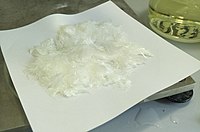
Photo from wikipedia
Abstract Biochar (BC) has been proposed as an effective and promising adsorbent for the remediation of contaminated soils. While growing numbers of studies have reported the adsorption and immobilization of… Click to show full abstract
Abstract Biochar (BC) has been proposed as an effective and promising adsorbent for the remediation of contaminated soils. While growing numbers of studies have reported the adsorption and immobilization of Cr(VI) on BC materials, very little is known about the mobility and retention of Cr-sorbed BC (Cr-BC) colloids, which may act as a carrier of the adsorbed Cr species, migrate along the soil profile and pose risk to deep subsurface environments. In this study, wheat straw BC samples prepared through pyrolysis at 450 °C and 600 °C (BC450 and BC600) were applied in Cr(VI) adsorption, and the resultant Cr-BC450 and Cr-BC600 colloids were further used to examine the effects of Cr(VI) adsorption amount, ionic strength and pyrolysis temperature on Cr-BC transport and retention in saturated porous media. Our results indicated that the reductive adsorption of Cr(VI) resulted in less negative zeta potential and enlarged hydrodynamic diameter of the BC colloids. For BC produced at a specific temperature, the mobility of Cr-BC colloids decreased with increasing Cr(VI) adsorption amount. For BC450 incubated with Cr(VI) (pH 2.0, 20 h), increasing ionic strength (1-5 mM NaCl) decreased the colloid mobility, and a transition from blocking to ripening occurred. In comparison to BC600, BC450 not only possessed higher Cr(VI) adsorption capacity, but also demonstrated higher mobility after Cr(VI) adsorption and reduction. The Derjaguin-Landau-Verwey-Overbeek theory and the two-site kinetic retention model were utilized to interpret the transport behaviors. Our findings suggested that the mobility of BC colloid was retarded after Cr(VI) adsorption and reduction, which could provide lasting benefits for Cr(VI) stabilization. However, the transport of Cr-BC cannot be neglected and should be considered during the application of BC in remediation of contaminated soil. This study for the first time revealed the importance of reductive adsorption in affecting the mobility of BC colloids. The transport of Cr species that associated with BC carriers should be considered during remediation of Cr(VI)-contaminated sites.
Journal Title: Colloids and Surfaces A: Physicochemical and Engineering Aspects
Year Published: 2020
Link to full text (if available)
Share on Social Media: Sign Up to like & get
recommendations!